| #2 Application of a Magnetic Rest Clasp for a Porcelain Fused to Metal Crown |
||
| Toshiaki Hasuike, Toshiyuki Kusano, Fumiko Okutsu, Takaaki Matsukawa, Mineyo Sone, and Shuji Ohkawa | ||
| Division of Removable Prosthodontics, Department of Restorative and Biomaterials Sciences, Meikai University School of Dentistry | ||
| @ | ||
| Introduction |
| The increased emphasis on physical appearance in contemporary
society has increased the demand for esthetic dental treatment. The metallic color of the buccal clasps on premolars or canines is one of the common causes of patient rejection. The appearance would be vastly improved if metal buccal clasps were eliminated. However, the retentive function of clasps without buccal arms is extremely poor. We developed a new retainer without a buccal clasp arm and with a magnetic attachment in the occlusal rest of the clasps (Magnetic Rest Clasp) (1,2). |
| @ |
| Objective |
| The purpose of this study is to introduce the fabrication of a new retainer, a gMagnetic Rest Clasp,h for porcelain fused to metal crowns on lower premolars with a plastic jaw model having artificial teeth. |
Materials and Methods |
|||||||||||||||||||||||||||||
| @ | |||||||||||||||||||||||||||||
|
Table 1@Materials used |
|||||||||||||||||||||||||||||
|
|||||||||||||||||||||||||||||
| @ | |||||||||||||||||||||||||||||
 |
|||||||||||||||||||||||||||||
| Fig. 1 Magnetic attachment a: keeper; b: keeper tray; c: magnetic assembly;
and d: housing pattern GIGAUSS C400 (GC) used in this study. |
|||||||||||||||||||||||||||||
| @ | |||||||||||||||||||||||||||||
| @ | |||||||||||||||||||||||||||||
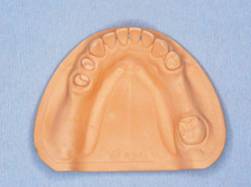 |
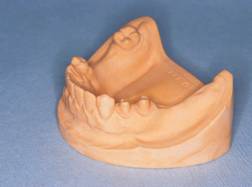 |
||||||||||||||||||||||||||||
| Figs. 2 and 3 Working model The working model is made from a plastic jaw model (DENTAL STUDY MODEL E50-526, NISSIN). |
|||||||||||||||||||||||||||||
| @ | |||||||||||||||||||||||||||||
| @ | |||||||||||||||||||||||||||||
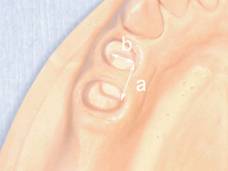 |
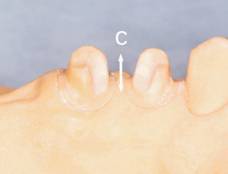 |
||||||||||||||||||||||||||||
| Fig.4 Working model (occlusal view of the abutments) Fig.5 Working model
(lingual view of the abutments) The abutments have partially concave forms for the magnetic attachment. a: 7.0mm b: 3.0mm c: 3.8mm |
|||||||||||||||||||||||||||||
| @ | |||||||||||||||||||||||||||||
 |
 |
||||||||||||||||||||||||||||
| Figs. 6 and 7 Wax pattern of porcelain fused to a connected metal crown The wax pattern has a guide plane on the lingual and distal sides. |
|||||||||||||||||||||||||||||
| @ | |||||||||||||||||||||||||||||
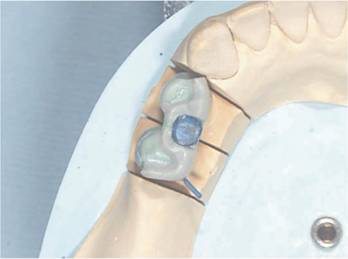 |
|||||||||||||||||||||||||||||
| Fig.8 Wax pattern with a keeper tray A minimum 0.3mm thickness of wax between the keeper and abutment is required for proper casting. |
|||||||||||||||||||||||||||||
| @ | |||||||||||||||||||||||||||||
| @ | |||||||||||||||||||||||||||||
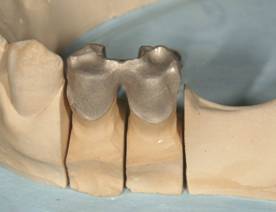 |
 |
||||||||||||||||||||||||||||
| Figs. 9 and 10 Framework of porcelain fused to a connected metal crown
without a keeper on the working model (buccal view and lingual view) The framework is cast with a type W gold alloy (Bio Herador N, Heraeus-Kulzer). |
|||||||||||||||||||||||||||||
| @ | |||||||||||||||||||||||||||||
| @ | |||||||||||||||||||||||||||||
 |
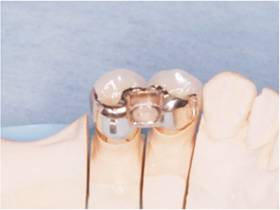 |
||||||||||||||||||||||||||||
| Figs. 11 and 12 Porcelain fused to a connected metal crown without a keeper on the working model (occlusal view and lingual view) The abutment crown has guide planes and channels. |
|||||||||||||||||||||||||||||
| @ | |||||||||||||||||||||||||||||
| @ | |||||||||||||||||||||||||||||
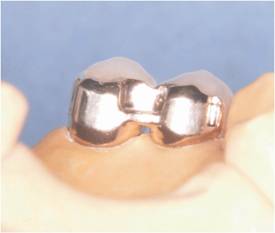 |
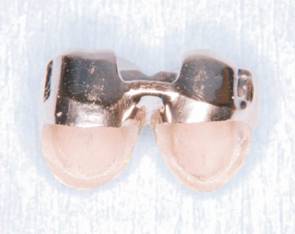 |
||||||||||||||||||||||||||||
| Figs. 13 and 14 Lingual view of porcelain fused to a connected metal crown A hygienic design is used for the gingival surface. |
|||||||||||||||||||||||||||||
| @ | |||||||||||||||||||||||||||||
| @ | |||||||||||||||||||||||||||||
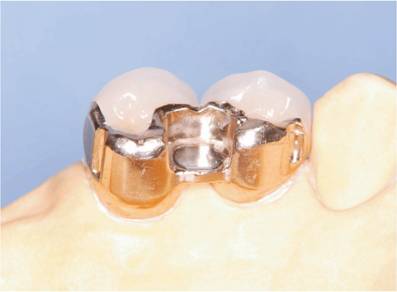 |
|||||||||||||||||||||||||||||
| Fig. 15 Porcelain fused to a connected metal crown with a keeper on the working model The keeper is fixed with a cementing material (Super-Bond C&B, SUN MEDICAL). |
|||||||||||||||||||||||||||||
| @ | |||||||||||||||||||||||||||||
| @ | |||||||||||||||||||||||||||||
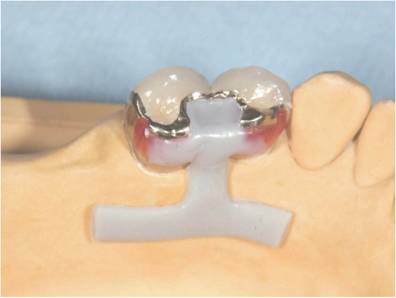 |
|||||||||||||||||||||||||||||
| Fig.16 Resin and wax pattern of the Magnetic Rest Clasp and minor connector
incorporating the housing pattern of the magnetic assembly (lingual view)
This pattern has no buccal clasp arm. |
|||||||||||||||||||||||||||||
| @ | |||||||||||||||||||||||||||||
| @ | |||||||||||||||||||||||||||||
 |
|||||||||||||||||||||||||||||
| Fig.17 Inner surface of the finished Magnetic Rest Clasp with a magnetic
assembly The Magnetic Rest Clasp is cast with a type W gold alloy (Bio Herador SG, Heraeus-Kulzer) and has a channel at the lingual clasp arm tip. |
|||||||||||||||||||||||||||||
| @ | |||||||||||||||||||||||||||||
| @ | |||||||||||||||||||||||||||||
 |
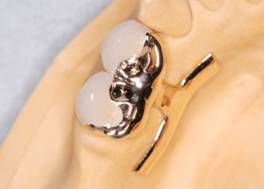 |
||||||||||||||||||||||||||||
| Figs. 18 and 19 Magnetic Rest Clasp seated in the porcelain fused to a connected metal crown on the working model (lingual view and occlusal view) | |||||||||||||||||||||||||||||
| @ | |||||||||||||||||||||||||||||
| @ | |||||||||||||||||||||||||||||
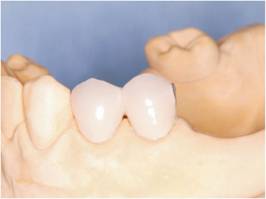 |
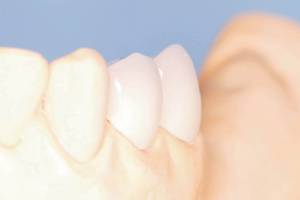 |
||||||||||||||||||||||||||||
| Figs. 20 and 21 Magnetic Rest Clasp seated in the porcelain fused to a
connected metal crown on the working model (buccal view and mesial view)
The advantages of the Magnetic Rest Clasp are esthetic. Among the disadvantages to the use of this clasp are its complex structure of abutment and problems for the patientfs intact teeth. |
|||||||||||||||||||||||||||||
| @ | |||||||||||||||||||||||||||||
| @ | |||||||||||||||||||||||||||||
| Conclusions |
| We introduced the fabrication of a new retainer, gMagnetic
Rest Clasp,h for porcelain fused to connected metal crowns on lower premolars
with a plastic jaw model. In the future, we will try to use the Magnetic
Rest Clasp in patients.
|
| @ |
| @ |
| References |
| 1. Hasuike T, Kusano T, Okutsu F, et al. An Application of a Magnetic
Attachment to aCast Clasp - Development of a Magnetic Rest Clasp -, J J
Mag Dent 18(1) :64-68, 2009. 2. Hasuike T, Kusano T, Okutsu F, et al. An Application of a Magnetic Attachment to a Cast Clasp - Development of a Magnetic Rest Clasp -, J J Mag Dent 18(2) :91-93, 2009 |